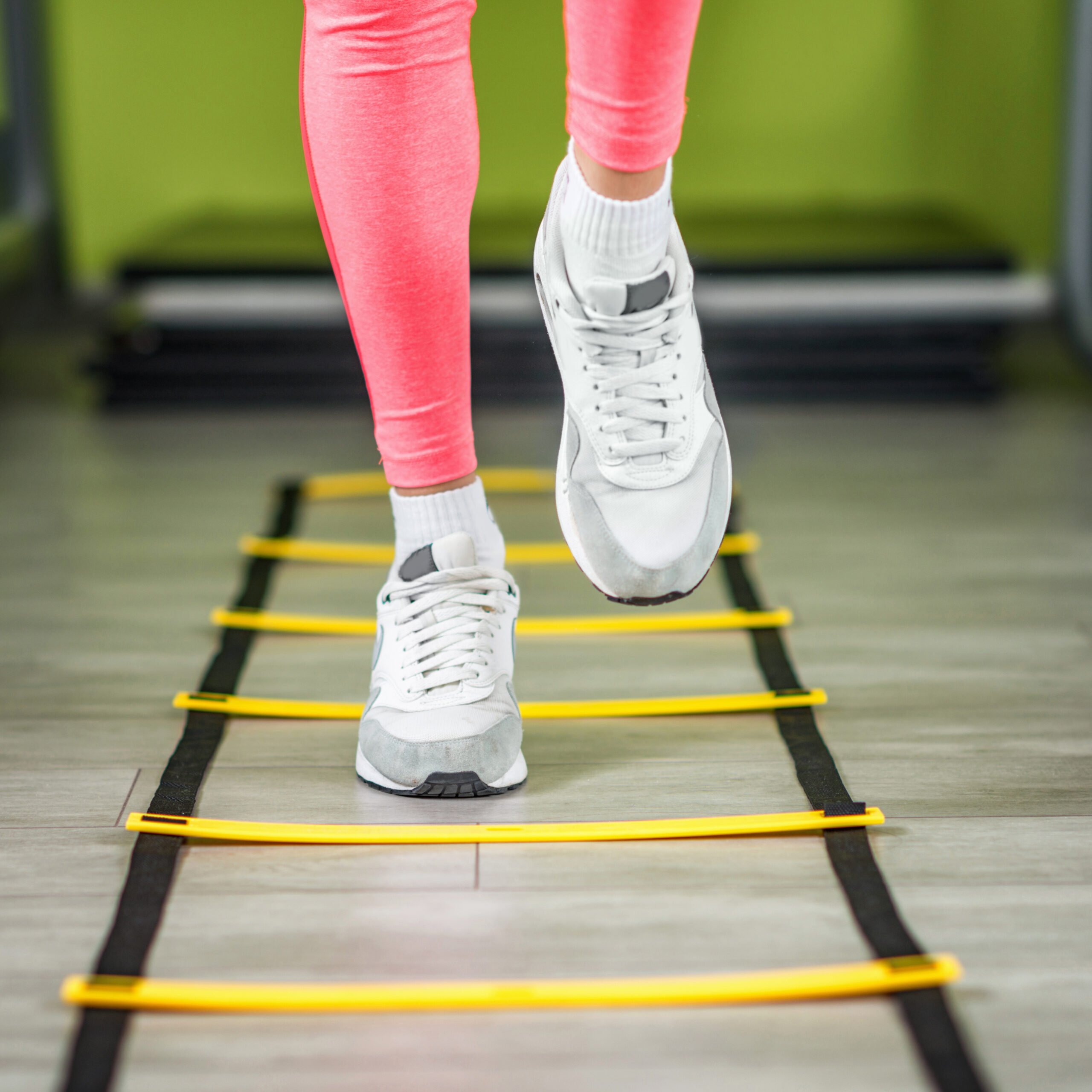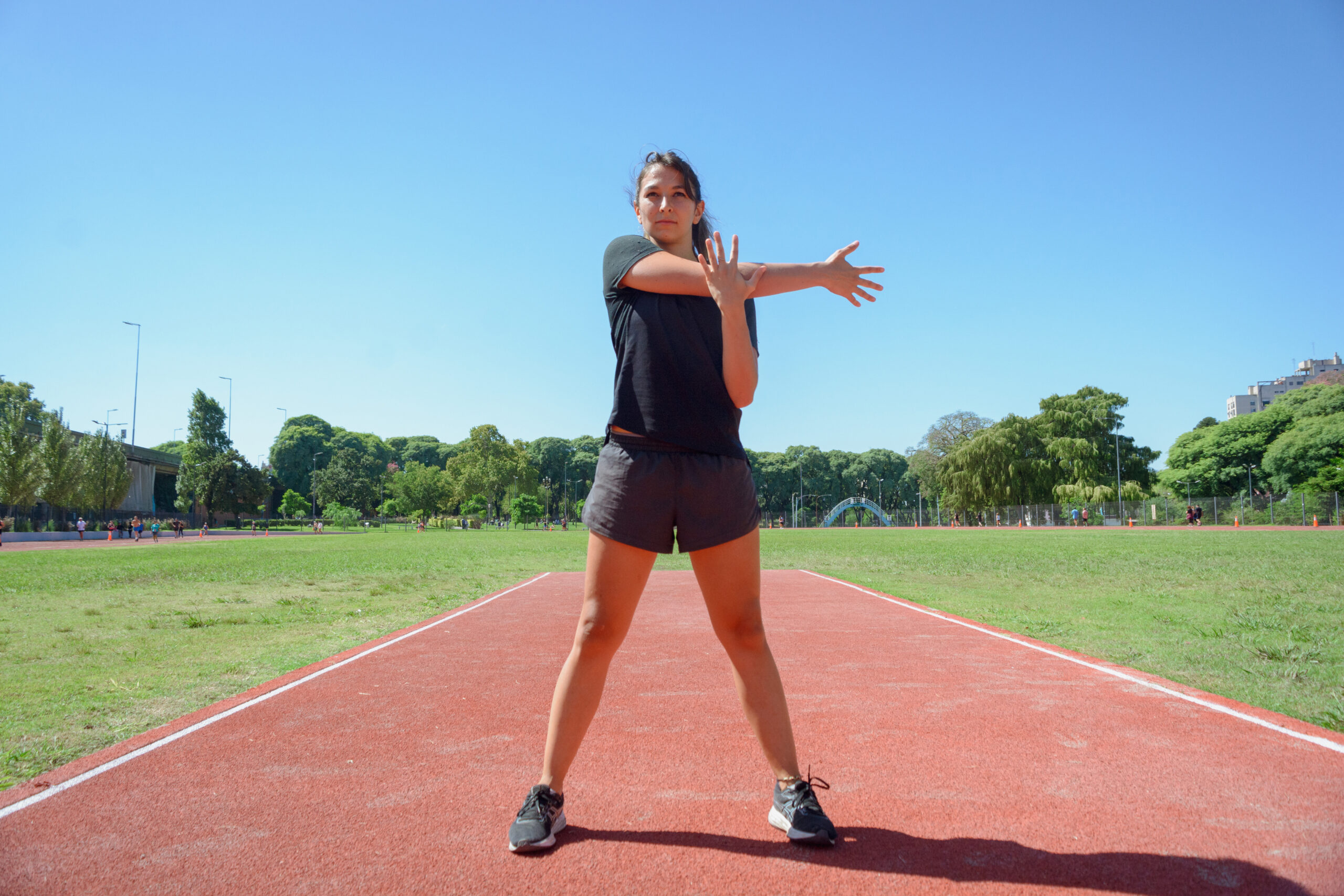Looking for the best agility ladder drills? Then you’ve come to the right place.
When I first heard about agility drills, I thought it was all about speed. But as I got into it, I quickly learned that agility is about much more than just running fast—it’s the ability to quickly change direction with control and precision.
I still remember my first agility ladder workout. I stumbled through it like a toddler learning to walk!
But with some persistence, I began to feel more coordinated and nimble, especially on those tricky trail runs where dodging rocks and roots is a must.
Today, I’m excited to share my go-to agility ladder workout with you. I’ll also why you should add agility drills to your training program, as well as how to get started.
Let’s get to it.
What Agility Ladder Drills Training?
Agility means switching direction swiftly and smoothly without losing your momentum, and that’s precisely what these ladder drills are all about.
For runners, this translates into better control over your foot placement, improved stride efficiency, and enhanced stability—skills that can help you become faster and more injury-resistant on the road or trail.
The quickest way to improve your multidirectional speed is by performing an agility ladder. These drills are exercises that help you improve your footwork, coordination, and overall agility by having you move through a ladder laid flat on the ground.
While popular in sports like football and basketball, these drills are also incredibly useful for us runners.
What’s An Agility Ladder
The agility ladder is this super handy piece of equipment that’s around 10 yards long. I snagged mine on Amazon, though you can easily DIY one with tape and sticks (more on this later).
Typical agility ladder exercises include skipping through runs, sideways shuffles, and other movements performed up and down the ladder. These exercises help to strengthen your muscles, ligaments, joints, and tendons while improving cardiovascular power, coordination, and focus.
Why Should Runners Do Agility Ladder Drills?
You might think agility ladders are just for other sports, but runners can reap huge benefits too
Here are some of the benefits to keep in mind:
Improved Neuromuscular Coordination
Agility drills help train the nervous system to coordinate with muscles more efficiently. Research found that agility training enhances neuromuscular coordination, leading to quicker reaction times and smoother transitions during movement.
For runners, this means better control over your foot placement, helping you maintain balance and adapt to different terrains more easily.
Enhanced Running Economy and Speed
According to research, agility training can contribute to running economy by improving stride efficiency. Runners who perform agility drills regularly are better able to control their body movements, which can help conserve energy during long-distance runs.
Reduced Injury Risk
Agility training enhances balance and proprioception (your body’s awareness of where it is in space). A study from the American Journal of Sports Medicine indicates that improved proprioception and balance from agility exercises can reduce the risk of injuries in athletes, including runners.
When your body responds more efficiently to uneven surfaces or quick shifts in terrain, you’re less likely to suffer from ankle sprains, missteps, or falls
For more on the history as well as proven benefits of ladder drills, check the following pages:
- Ladder drills on Wikipedia
- The Benefits of Ladder Exercises
- Effects of Training with an Agility Ladder
- Effects of 6-week agility ladder drills during recess intervention on dynamic balance performance
- The Influence of Agility Training on Physiological and Cognitive Performance
How To Create Your Agility Ladder
One weekend, I decided to make a DIY agility ladder. I bought some duct tape and used paint-stirring sticks for the rungs. It took me about an hour to measure and tape everything down in the garage, but it turned out great.
If you’re feeling crafty, give it a try. It’s a cool project, and it feels more personal when training with something you made.
Here’s what you’ll need to get started::
- Two rolls of duct tape—or at least 25 to 30 feet.
- A pair of scissors
- 10 Paint-stirring sticks. Get the big ones, which are roughly 20 inches long. You can get them for free at the paint counter at Home Depot.
- A measuring tape.
Next, you only need a few minutes to put this whole project together.
Too much to handle? You can always draw it on the floor or use scotch tape if you’re working out indoors. The key is just to get started.
Agility Ladder Dimensions
As for dimensions, the rungs are often spaced 18 inches apart, forming boxes that are 20 inches wide.
Agility ladders are roughly 10 yards long and come in five-yard sections.
Just remember to leave at least 16 inches between each rung.
You can also join multiple sections to create ladders longer than ten yards. It’s up to you.
This YouTube Tutorial shows you exactly how to put everything together.
Starting Agility Ladder Exercises
The first time I tried an agility ladder, I was so eager to start that I jumped right into it and ended up tripping over myself.
Here’s my advice: take it slow at first! Walk through the ladder to get the hang of it, then slowly build up your speed. I still laugh when I remember how clumsy I was in the beginning.
Here are a few steps to help you get started:
- Set Up the Ladder: Lay your agility ladder in a flat, open space. You can create a DIY version using chalk or tape if you don’t have one.
- Warm-Up: Before jumping into agility drills, warm up for 5-10 minutes. Jogging in place, dynamic stretches like lunges and leg swings, or a light jog around the block will help get your muscles ready for the more intense movements.
- Start Slow: If you’re new to agility drills, walk through each drill slowly to get a feel for the movements. Focus on proper form before trying to speed things up.
- Build Up Speed: Once you’re comfortable with the form, increase the speed of the drills. You aim to move quickly through the ladder while maintaining control and precision.
Top 9 Speed & Agility Ladder Drills For Runners
Here are nine of my favorite agility ladder drills, designed to help you improve footwork, speed, and coordination. These drills are perfect for runners of all levels.
To get the most out of agility drills, aim to do them at least twice a week. You can include them as part of your warm-up or cool-down after a run, or dedicate specific workouts to agility training. Start with 30 seconds to 1 minute per drill, and as you progress, you can increase the intensity or add more complex drills to your routine.
Ladder Linear Speed Drill
Begin this basic drill behind the ladder. Then, run down the center of the ladder, with each foot coming in contact with the boxes.
Next, turn around and run back to the starting position. Ensure to reduce the time your feet are in contact with the ground.
This is the drill that clicked for me. It’s simple but effective. The first time I did it right, I felt this rush of satisfaction seeing myself move quicker through each box.
High Knees Agility Ladder
Begin by stepping into the first box with both feet, then run forward with high knees, lifting your knees to waist level, through the entire length of the ladder.
Bend your arms at 90 degrees and swing them back and forth to generate momentum.
Last up, turn around and sprint to the starting point.
I like to imagine I’m stomping grapes when I do this one—lifting my knees high while keeping my arms pumping. It’s funny, but that mental image helped me get the rhythm down!
Lateral Agility Quick Steps
While standing with the agility ladder on your right, start sprinting laterally through the agility ladder by lifting your right foot ankle high and into the first box as quickly as you can, then follow it immediately with your left foot, moving diagonally forward one box until you reach the end of the ladder.
Speed requires stability in your ankle. Protect your ankle by landing safely with balls of your feet with toes pointing up.
The first time I nailed this drill, I felt like an athlete, darting side to side with quick, sharp movements. It’s amazing how these drills can make everyday activities feel easier, like dodging through crowds or avoiding puddles.
Carioca Agility Ladder Drill
Begin by standing on the right side of the agility ladder, then step sideways with your lead foot into the first box, then cross-step your rear foot behind your lead into the second box.
Continue moving laterally across the ladder facing one direction while focusing on quick hip rotation and fast footwork. Then repeat in the opposite direction.
It’s like dancing! This drill reminds me of doing the grapevine dance step in school gym class. I still trip up occasionally, but that’s part of the fun—getting better each time.
In & Out Ladder Drill
Begin with your feet hip-width apart at the bottom of the agility ladder.
Next, hop into the first box, landing with both feet in the center.
Then, hop forward to the second box, spreading your legs and landing so both feet are outside the agility ladder, then jump to the third box, bringing your feet back to the middle position.
Continue down the entire length of the ladder, then hop backward following the same pattern.
This one made me realize how much coordination matters. I started slow, focusing on getting each step right, and as I sped up, it felt like my feet were learning a new dance.
Ickey Shuffle Speed Ladder Drill
Start on the left side of the agility ladder, then take a lateral step to the right with your right foot into the first box, then immediately follow it with your left foot.
Step laterally to the left side of the ladder with your left foot, and move your right foot to the next box.
Next, bring your left foot to meet your right, then step laterally to your right side of the speed ladder, and move your left to the next box in front of you.
Continue down the entire length of the ladder, then perform the same drill backward.
I love this drill because it feels like a rhythm challenge. When you get into a groove, it’s like you’re shuffling to a beat only you can hear.
Two-footed Forward/Backward Jumps Agility Drill
Stand facing the agility ladder. Next, jump into the second box, then jump backward to the first box, then jump again forward to the third box, then back again to the second box.
Keep jumping back and forth until you have gone the length of the entire ladder, then turn back and repeat.
Make sure to stay up on the ball of your feet the entire time.
And never forget, technique comes first, speed later. You can always add more speed easily by time. But to fix technique and alignment takes forever.
Talk about a leg burner! This drill helped me build explosive strength and quick reflexes. At first, I was a bit wobbly, but over time, I could feel my legs getting more powerful and stable.
Lateral Shuffle Speed Ladder Drill
Stand with your feet a little wider than hip-width to the right side of the agility ladder, then step sideways with your left foot into the first box, follow it right away with your right foot.
Next, step sideways with your left foot into the second box then bring your right foot into that box.
Make sure to move through the entire length of the ladder touching both feet in each box, while keeping your chest up, back straight and eyes gazing straight ahead of you the entire time.
Repeat the sequence in the other direction to complete one rep.
This made me realize the importance of keeping a low center of gravity. I’d crouch slightly, and it felt like I was ready to sprint in any direction at any moment. It’s an awesome feeling.
Lateral Single-Leg Hops
Begin by standing on your right foot, standing sideways on the right side of the ladder, then hop through the ladder on your right foot.
Once you reach the end of the ladder, turn around, then hop back. Switch sides and repeat. Tips! I love to start with a strong side first. You can do reps with less strong side twice than the strong one. Two birds in one stone, agility, and balance in one go.
Balancing on one leg and hopping through the ladder took some getting used to. My first few tries were shaky, but I focused on keeping my core tight, and now it’s one of my go-to drills.
Frequently Asked Questions About Agility Ladder Drills
I know that you have more questions about agility ladder training. Let me try to address some of them.
How long should I do agility drills?
Agility drills don’t require a lot of time to be effective. Aim for 10-15 minutes per session, 2-3 times a week. This will allow you to build coordination and speed without overloading your muscles.
Do I need to be an advanced runner to start agility training?
Not at all! Agility drills are adaptable for runners of all levels. Beginners can start with simple footwork patterns to build a foundation, while advanced runners can add speed and complexity to their drills.
What type of surface is best for agility ladder drills?
A flat, non-slip surface is ideal for agility ladder drills. Grass, turf, or a gym floor are all great options that provide good grip and reduce the risk of slipping. Avoid uneven or hard surfaces like concrete, as they can increase the risk of injury.
Share Your Agility Training Tips!
Agility ladder drills can add a whole new dimension to your running routine, and every runner’s experience is unique. Have you found a favorite agility drill that’s boosted your speed or helped you stay injury-free? Maybe you have a tip for mastering tricky footwork?
Your insights could inspire and help other runners looking to take their agility training to the next level!
Looking for the best agility ladder drills? Then you’ve come to the right place.
When I first heard about agility drills, I thought it was all about speed. But as I got into it, I quickly learned that agility is about much more than just running fast—it’s the ability to quickly change direction with control and precision.
I still remember my first agility ladder workout. I stumbled through it like a toddler learning to walk!
But with some persistence, I began to feel more coordinated and nimble, especially on those tricky trail runs where dodging rocks and roots is a must.
Today, I’m excited to share my go-to agility ladder workout with you. I’ll also why you should add agility drills to your training program, as well as how to get started.
Let’s get to it.
What Agility Ladder Drills Training?
Agility means switching direction swiftly and smoothly without losing your momentum, and that’s precisely what these ladder drills are all about.
For runners, this translates into better control over your foot placement, improved stride efficiency, and enhanced stability—skills that can help you become faster and more injury-resistant on the road or trail.
The quickest way to improve your multidirectional speed is by performing an agility ladder. These drills are exercises that help you improve your footwork, coordination, and overall agility by having you move through a ladder laid flat on the ground.
While popular in sports like football and basketball, these drills are also incredibly useful for us runners.
What’s An Agility Ladder
The agility ladder is this super handy piece of equipment that’s around 10 yards long. I snagged mine on Amazon, though you can easily DIY one with tape and sticks (more on this later).
Typical agility ladder exercises include skipping through runs, sideways shuffles, and other movements performed up and down the ladder. These exercises help to strengthen your muscles, ligaments, joints, and tendons while improving cardiovascular power, coordination, and focus.
Why Should Runners Do Agility Ladder Drills?
You might think agility ladders are just for other sports, but runners can reap huge benefits too
Here are some of the benefits to keep in mind:
Improved Neuromuscular Coordination
Agility drills help train the nervous system to coordinate with muscles more efficiently. Research found that agility training enhances neuromuscular coordination, leading to quicker reaction times and smoother transitions during movement.
For runners, this means better control over your foot placement, helping you maintain balance and adapt to different terrains more easily.
Enhanced Running Economy and Speed
According to research, agility training can contribute to running economy by improving stride efficiency. Runners who perform agility drills regularly are better able to control their body movements, which can help conserve energy during long-distance runs.
Reduced Injury Risk
Agility training enhances balance and proprioception (your body’s awareness of where it is in space). A study from the American Journal of Sports Medicine indicates that improved proprioception and balance from agility exercises can reduce the risk of injuries in athletes, including runners.
When your body responds more efficiently to uneven surfaces or quick shifts in terrain, you’re less likely to suffer from ankle sprains, missteps, or falls
For more on the history as well as proven benefits of ladder drills, check the following pages:
- Ladder drills on Wikipedia
- The Benefits of Ladder Exercises
- Effects of Training with an Agility Ladder
- Effects of 6-week agility ladder drills during recess intervention on dynamic balance performance
- The Influence of Agility Training on Physiological and Cognitive Performance
How To Create Your Agility Ladder
One weekend, I decided to make a DIY agility ladder. I bought some duct tape and used paint-stirring sticks for the rungs. It took me about an hour to measure and tape everything down in the garage, but it turned out great.
If you’re feeling crafty, give it a try. It’s a cool project, and it feels more personal when training with something you made.
Here’s what you’ll need to get started::
- Two rolls of duct tape—or at least 25 to 30 feet.
- A pair of scissors
- 10 Paint-stirring sticks. Get the big ones, which are roughly 20 inches long. You can get them for free at the paint counter at Home Depot.
- A measuring tape.
Next, you only need a few minutes to put this whole project together.
Too much to handle? You can always draw it on the floor or use scotch tape if you’re working out indoors. The key is just to get started.
Agility Ladder Dimensions
As for dimensions, the rungs are often spaced 18 inches apart, forming boxes that are 20 inches wide.
Agility ladders are roughly 10 yards long and come in five-yard sections.
Just remember to leave at least 16 inches between each rung.
You can also join multiple sections to create ladders longer than ten yards. It’s up to you.
This YouTube Tutorial shows you exactly how to put everything together.
Starting Agility Ladder Exercises
The first time I tried an agility ladder, I was so eager to start that I jumped right into it and ended up tripping over myself.
Here’s my advice: take it slow at first! Walk through the ladder to get the hang of it, then slowly build up your speed. I still laugh when I remember how clumsy I was in the beginning.
Here are a few steps to help you get started:
- Set Up the Ladder: Lay your agility ladder in a flat, open space. You can create a DIY version using chalk or tape if you don’t have one.
- Warm-Up: Before jumping into agility drills, warm up for 5-10 minutes. Jogging in place, dynamic stretches like lunges and leg swings, or a light jog around the block will help get your muscles ready for the more intense movements.
- Start Slow: If you’re new to agility drills, walk through each drill slowly to get a feel for the movements. Focus on proper form before trying to speed things up.
- Build Up Speed: Once you’re comfortable with the form, increase the speed of the drills. You aim to move quickly through the ladder while maintaining control and precision.
Top 9 Speed & Agility Ladder Drills For Runners
Here are nine of my favorite agility ladder drills, designed to help you improve footwork, speed, and coordination. These drills are perfect for runners of all levels.
To get the most out of agility drills, aim to do them at least twice a week. You can include them as part of your warm-up or cool-down after a run, or dedicate specific workouts to agility training. Start with 30 seconds to 1 minute per drill, and as you progress, you can increase the intensity or add more complex drills to your routine.
Ladder Linear Speed Drill
Begin this basic drill behind the ladder. Then, run down the center of the ladder, with each foot coming in contact with the boxes.
Next, turn around and run back to the starting position. Ensure to reduce the time your feet are in contact with the ground.
This is the drill that clicked for me. It’s simple but effective. The first time I did it right, I felt this rush of satisfaction seeing myself move quicker through each box.
High Knees Agility Ladder
Begin by stepping into the first box with both feet, then run forward with high knees, lifting your knees to waist level, through the entire length of the ladder.
Bend your arms at 90 degrees and swing them back and forth to generate momentum.
Last up, turn around and sprint to the starting point.
I like to imagine I’m stomping grapes when I do this one—lifting my knees high while keeping my arms pumping. It’s funny, but that mental image helped me get the rhythm down!
Lateral Agility Quick Steps
While standing with the agility ladder on your right, start sprinting laterally through the agility ladder by lifting your right foot ankle high and into the first box as quickly as you can, then follow it immediately with your left foot, moving diagonally forward one box until you reach the end of the ladder.
Speed requires stability in your ankle. Protect your ankle by landing safely with balls of your feet with toes pointing up.
The first time I nailed this drill, I felt like an athlete, darting side to side with quick, sharp movements. It’s amazing how these drills can make everyday activities feel easier, like dodging through crowds or avoiding puddles.
Carioca Agility Ladder Drill
Begin by standing on the right side of the agility ladder, then step sideways with your lead foot into the first box, then cross-step your rear foot behind your lead into the second box.
Continue moving laterally across the ladder facing one direction while focusing on quick hip rotation and fast footwork. Then repeat in the opposite direction.
It’s like dancing! This drill reminds me of doing the grapevine dance step in school gym class. I still trip up occasionally, but that’s part of the fun—getting better each time.
In & Out Ladder Drill
Begin with your feet hip-width apart at the bottom of the agility ladder.
Next, hop into the first box, landing with both feet in the center.
Then, hop forward to the second box, spreading your legs and landing so both feet are outside the agility ladder, then jump to the third box, bringing your feet back to the middle position.
Continue down the entire length of the ladder, then hop backward following the same pattern.
This one made me realize how much coordination matters. I started slow, focusing on getting each step right, and as I sped up, it felt like my feet were learning a new dance.
Ickey Shuffle Speed Ladder Drill
Start on the left side of the agility ladder, then take a lateral step to the right with your right foot into the first box, then immediately follow it with your left foot.
Step laterally to the left side of the ladder with your left foot, and move your right foot to the next box.
Next, bring your left foot to meet your right, then step laterally to your right side of the speed ladder, and move your left to the next box in front of you.
Continue down the entire length of the ladder, then perform the same drill backward.
I love this drill because it feels like a rhythm challenge. When you get into a groove, it’s like you’re shuffling to a beat only you can hear.
Two-footed Forward/Backward Jumps Agility Drill
Stand facing the agility ladder. Next, jump into the second box, then jump backward to the first box, then jump again forward to the third box, then back again to the second box.
Keep jumping back and forth until you have gone the length of the entire ladder, then turn back and repeat.
Make sure to stay up on the ball of your feet the entire time.
And never forget, technique comes first, speed later. You can always add more speed easily by time. But to fix technique and alignment takes forever.
Talk about a leg burner! This drill helped me build explosive strength and quick reflexes. At first, I was a bit wobbly, but over time, I could feel my legs getting more powerful and stable.
Lateral Shuffle Speed Ladder Drill
Stand with your feet a little wider than hip-width to the right side of the agility ladder, then step sideways with your left foot into the first box, follow it right away with your right foot.
Next, step sideways with your left foot into the second box then bring your right foot into that box.
Make sure to move through the entire length of the ladder touching both feet in each box, while keeping your chest up, back straight and eyes gazing straight ahead of you the entire time.
Repeat the sequence in the other direction to complete one rep.
This made me realize the importance of keeping a low center of gravity. I’d crouch slightly, and it felt like I was ready to sprint in any direction at any moment. It’s an awesome feeling.
Lateral Single-Leg Hops
Begin by standing on your right foot, standing sideways on the right side of the ladder, then hop through the ladder on your right foot.
Once you reach the end of the ladder, turn around, then hop back. Switch sides and repeat. Tips! I love to start with a strong side first. You can do reps with less strong side twice than the strong one. Two birds in one stone, agility, and balance in one go.
Balancing on one leg and hopping through the ladder took some getting used to. My first few tries were shaky, but I focused on keeping my core tight, and now it’s one of my go-to drills.
Frequently Asked Questions About Agility Ladder Drills
I know that you have more questions about agility ladder training. Let me try to address some of them.
How long should I do agility drills?
Agility drills don’t require a lot of time to be effective. Aim for 10-15 minutes per session, 2-3 times a week. This will allow you to build coordination and speed without overloading your muscles.
Do I need to be an advanced runner to start agility training?
Not at all! Agility drills are adaptable for runners of all levels. Beginners can start with simple footwork patterns to build a foundation, while advanced runners can add speed and complexity to their drills.
What type of surface is best for agility ladder drills?
A flat, non-slip surface is ideal for agility ladder drills. Grass, turf, or a gym floor are all great options that provide good grip and reduce the risk of slipping. Avoid uneven or hard surfaces like concrete, as they can increase the risk of injury.
Share Your Agility Training Tips!
Agility ladder drills can add a whole new dimension to your running routine, and every runner’s experience is unique. Have you found a favorite agility drill that’s boosted your speed or helped you stay injury-free? Maybe you have a tip for mastering tricky footwork?
Your insights could inspire and help other runners looking to take their agility training to the next level!





